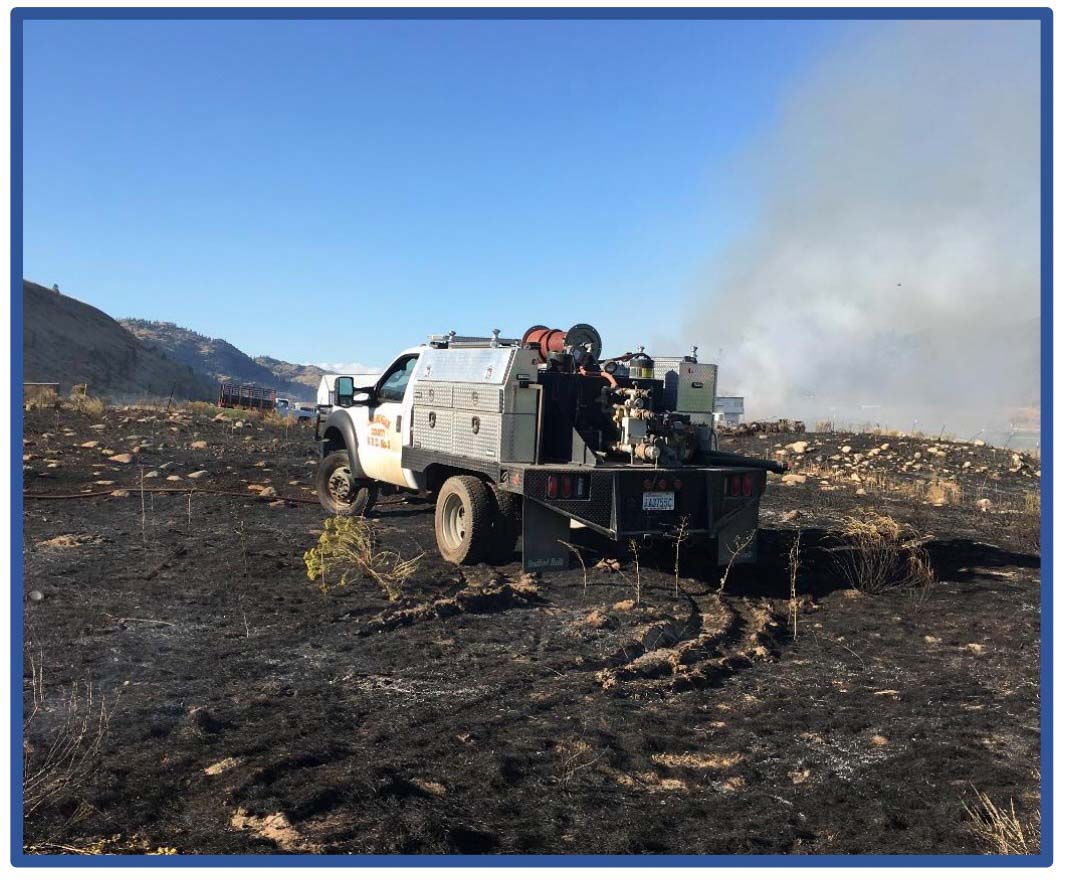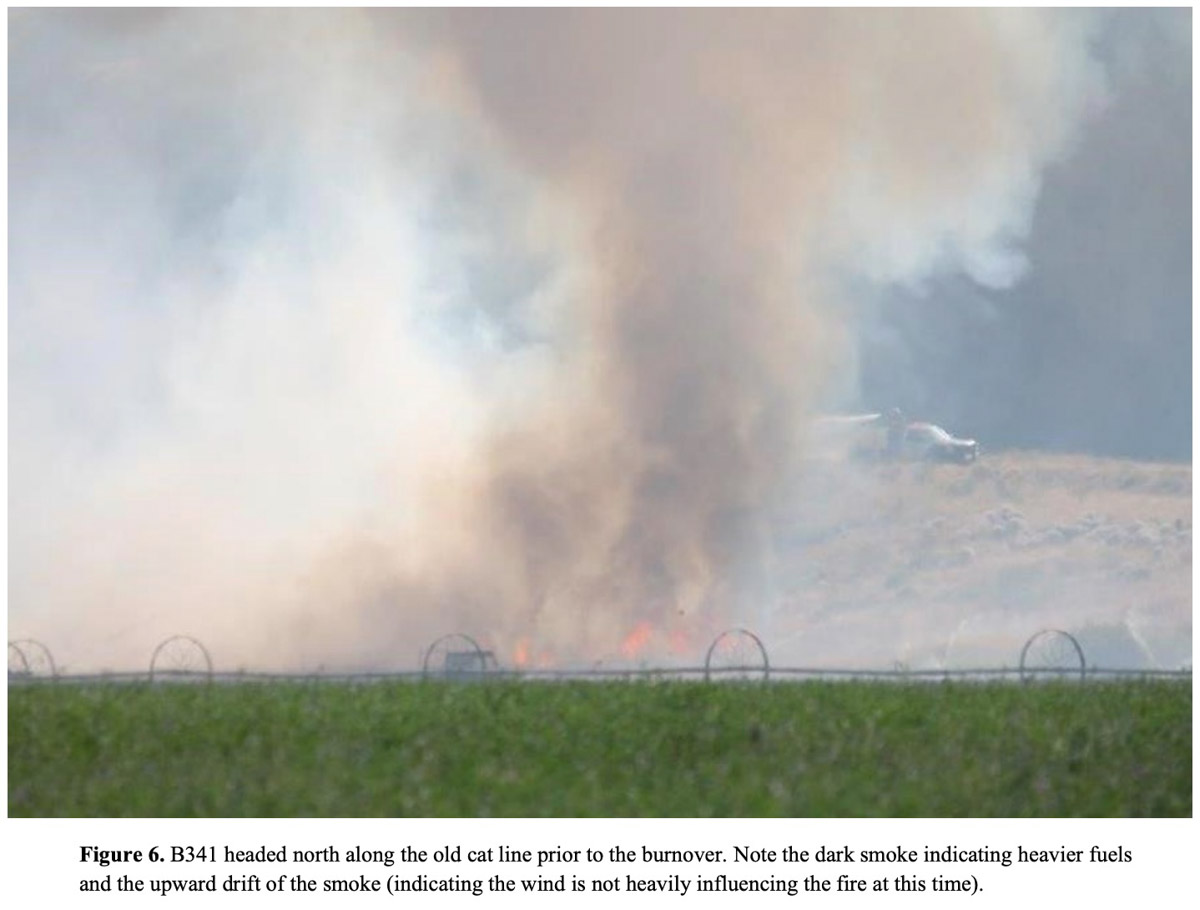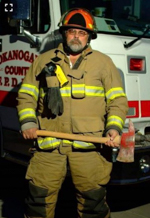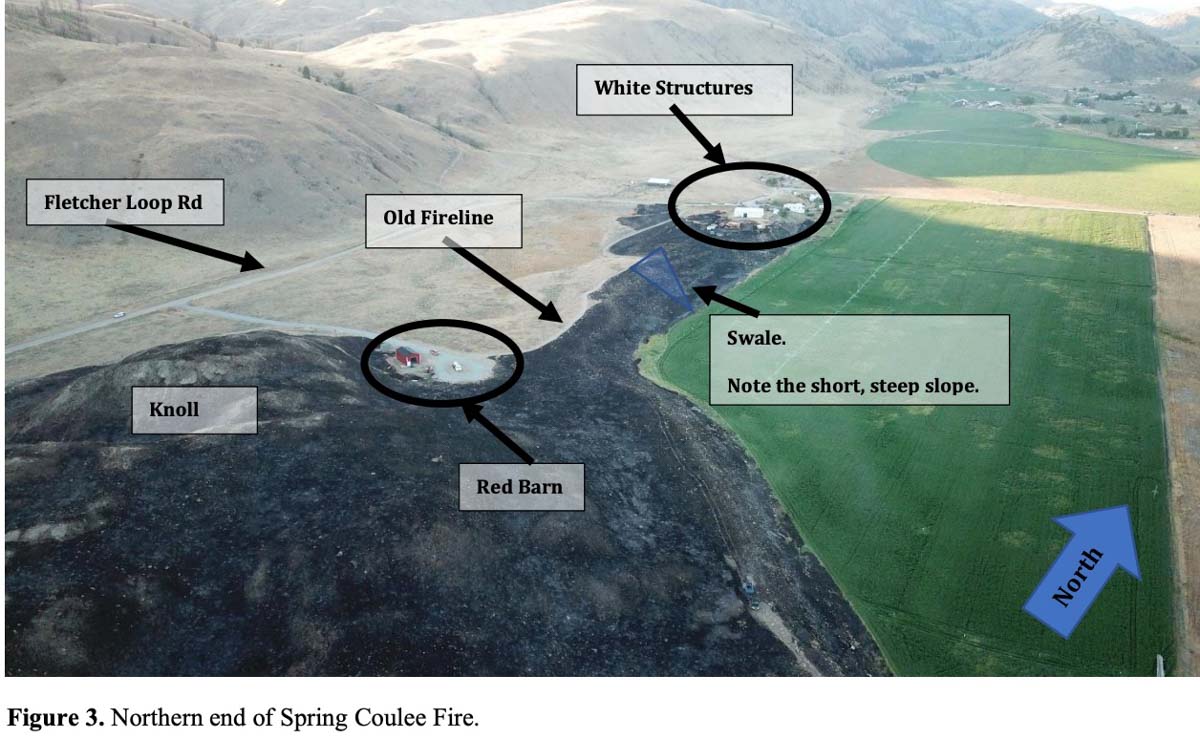
A facilitated learning analysis has been released for a burnover and entrapment on the Spring Coulee Fire September 1, 2019 near Okanogan, Washington. A month after suffering burns over 60 percent of his body, Assistant Fire Chief Christian Dean Johnson, 55, passed away in a hospital as a result of his injuries.
The events unfolded quickly on September 1. After being reported at about 1600 the Incident Commander sized it up nine minutes later at five to ten acres spreading rapidly in grass and brush.
Wearing his turnout pants, Assistant Chief Johnson loaded into B341 (a 2012 Ford F450 Type 6 Brush Truck) and stowed his turnout jacket on the back of the truck between the cab and a rear-mounted storage compartment. At 1615 the Chief arrived at the fire with another firefighter. Eleven minutes later a MAYDAY was called for the entrapment.
Upon arrival Chief Johnson and the firefighter, identified as the “external firefighter” in the report, began a mobile attack, with the Chief driving the truck and the firefighter operating a nozzle. They were working along an old cat trail from an earlier fire, identified as “Old Fireline” on the aerial photo. 
After a few minutes the wind direction shifted from blowing parallel with the cat line, generally south, to southeasterly and aligned with the small swale shown on the aerial photo. This pushed the fire rapidly toward the road and the two firefighters. The Chief yelled at the other firefighter to drop the hose and move.
From the report:
The exterior firefighter didn’t open the passenger door; fire was immediately at his back and had caught the passenger mirror on fire. He ran around to the driver’s side of B341 and climbed on the outside of the truck again. As fire moved under B341, Assistant Chief Johnson attempted to drive B341 away from the area. After traveling five or six feet, B341 “lurched” and then became immobilized. With flames rolling up the exterior firefighter’s legs, visible on the passenger side of the vehicle itself, under the truck and in front of them, both the exterior firefighter and Assistant Chief Johnson exited the vehicle to escape the fire. Assistant Chief Johnson and the exterior firefighter ran toward the old cat trail at slightly different angles. In Assistant Chief Johnson’s path, hidden by vegetation, lay a substantial field of rocks and metal debris (Figure 9). While it is impossible to know for certain, it is thought Assistant Chief Johnson may have become entangled in the debris and was overtaken by fire.

The exterior firefighter, with fire surrounding him—and at times reaching up between his legs—was able to escape the advancing fire. The exterior firefighter and the fire reached the road at approximately the same instant.
As it was starved of fuel, the roaring and crackling of the fire quieted and the exterior firefighter from B341 immediately turned around to head back into the black and reestablish contact with Assistant Chief Johnson. The firefighter located Assistant Chief Johnson approximately 150 feet from the exterior of B341. The MAYDAY was called at 1626.
[…]
Just before 1655, the surface winds shifted to a south-southwesterly direction. This pushed a “finger” of fire north of the structures on the eastern flank and increased fire behavior in the area. At approximately 1655, the engine on the eastern flank requested air support as “we are trapped here” and they needed water to continue effective structure protection. A helicopter in the area had already spotted the flare-up and was able to deliver water within seconds of the radio call. At least one additional water drop was completed by a [single engine air tanker].
The report does not specify exactly where the first burnover occurred, but there are clues that it was near the “Swale.”
During the burnover the Chief was not wearing his turnout jacket, which after the incident was still stowed behind the truck’s cab. The report concluded that the lack of personal protective equipment above the waist contributed to the severity of his injuries.
The external firefighter was quoted as saying, “The only reason I am alive is because I had all this [structural] gear on. Without that I wouldn’t have even made it back to the truck.”
The investigation found a low oxygen code recorded in the truck’s electronic system. There was no time associated with the code, so it can’t be determined if it occurred while the vehicle was surrounded by fire or if it was the cause or symptom of the truck being immobilized.
There have been a number of incidents in which firefighting vehicles stalled in very dense smoke.
- In 2008 three firefighters suffered burn injuries in North Dakota after their truck stalled due to what was thought to be oxygen starvation.
- The Pratt Tribune reported in 2010 that “smoke suffocated the carburetor” causing the engine on a brush truck to stall. The firefighters on the truck escaped unharmed into the black, or previously burned area, but the truck was not as fortunate.
- The report on the death of one firefighter at the 2011 Coal Canyon Fire in South Dakota does not speculate why the engine on a truck died in heavy smoke as the fire overran the vehicle with two people inside. Two firefighters were entrapped in the engine. One remained entrapped and died; the other escaped.
Personnel involved in the Spring Coulee Fire highlighted six core lessons. These lessons are focused on communications, training, medical pre-positioning and medical evacuation coordination, vehicles, access, and personal protective equipment.
The Epilog is from the report:

“Christian Johnson, 55, of Okanogan, Washington passed away Wednesday, October 2, 2019 from injuries sustained in the Spring Coulee Fire south of Okanogan. Christian was born in 1963 in Salem, Oregon, to James and Margaret Johnson. He grew up in Salem, graduating from South Salem High School in 1982. Christian began college at Oregon State University, but felt he had a larger calling and joined the Army. Christian served from 1983-1986 in the 82nd Airborne Division where he achieved the rank of Sergeant. After being honorably discharged, Christian continued his duty by joining the Oregon Army National Guard. He then returned to college and graduated from Chemeketa Community College in Salem in 1988 with an A.A. in Building Inspection Technology. Christian accepted a position as a building inspector in Washington for Okanogan County and later transferred as building official and permit administrator to the cities of Oroville, Tonasket, and Okanogan. He also transferred to the Washington National Guard where, along with his Charlie Company of the 1-161 Infantry Regiment, he deployed to Iraq. Christian served from November 2003–April 2005. Upon returning home, Christian retired from the National Guard after a total of 22 years of service. In Okanogan, Christian found another call to duty and in May of 1999, he joined the Okanogan Fire Department where he served as the Assistant Fire Chief and Secretary of the Okanogan Volunteer Fire Department Association.”
May Chief Johnson rest in peace.


The FLA listed these as focus items: “Personnel involved in the Spring Coulee Fire highlighted six core lessons. These lessons are focused on communications, training, medical pre-positioning and medical evacuation coordination, vehicles, access, and personal protective equipment.”
Communications (or lack of) are involved in every wildland fire fatality. It is glaringly obvious from the list above that one of the key FLA Team ingredients missing from the above list is human factors. Human factors are a major component of every wildland fire fatality. They are responsible for good decisions with good outcomes as well as the opposite, including bad decisions with good outcomes.
It is most unfortunate that the movement away from investigations has been replaced with this new style of “learning reviews” that find no blame and no fault. Wildland fire fatalities, like fatalities in all work groups, are inevitable. And the reason this is so, is because of human factors. All we can do is lessen or reduce them.
However, that requires that we learn “complete” lessons. This is something we are not learning with these FLAs when we exclude examining and discussing the human factors elements.
Thank you for publishing this honest, thoughtful report.
It’s a tribute to Chief Anderson that we are able to learn from his tragic death.
In my state, NJ, historically nearly every wildland fire fatality involved not being able to drive away from the fire due to the vehicle becoming stuck or disabled.
Years ago the Missoula Fire Lab measured O2 depletion above the flames in some intense prescribed fires and measured <3%. I’m speculating that other causes of vehicle failure might include heat causing electronics failure or physical damage to a key component (e.g., plastic/rubber hose), smoke clogging something, etc. If not already done, a study of how to upgrade vehicles to survive fire-related stresses seems very worthwhile.